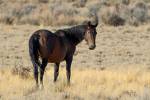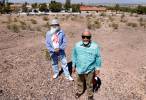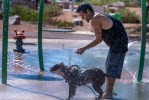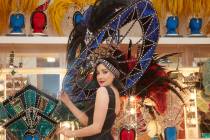Neon Museum looks for a sign at Tuesday painters’ panel






Think of a neon sign. Now that you’ve thought of one, think again. Are you focusing on the neon itself, or the painted sign providing a backdrop for the glow?
Thought so.
Yet you may decide to take a second look, thanks to the Neon Museum’s “Unsigned Heroes: Sign Painters’ Art and Stories,” a Tuesday panel discussion focusing on painted signs and the often overlooked role they play in showcasing fanciful neon designs.
People “think of the neon and gas tubes” when they consider neon signs, acknowledges Rob McCoy, who chairs the Neon Museum’s board of directors. “But painting is an integral part of neon signage,” especially when there’s “lots of sunshine,” which means “the neon’s not on, so the painting’s very important.”
Lectures and panel discussions such as Tuesday’s “bring the museum’s collection to life,” McCoy notes. “There is a story and a history behind each and every sign.”
Take the Desert Rose Motel sign that’s part of the museum’s collection — and is “at the forefront of our brains,” according to McCoy, because it’s in such desperate need of restoration.
Museum officials have begun a campaign to raise the approximately $60,000 they’ll need to bring what’s “not a large sign” back to its former glory, McCoy says. “That just gives you an indication about the detail” involved in sign restoration.
Tuesday’s panelists will provide even more detail about the art and craft of painted signs.
They include photographers Geoffrey Ellis and Bryan McCormick, founders of the Vegas Vernacular Project, a two-year study of Southern Nevada’s commercial signage.
Filmmakers Faythe Levine and Sam Macon — whose documentary “Sign Painters” focuses on the artists themselves — also will participate in the discussion. (Following the panel , they’ll autograph copies of their “Sign Painters” book in the museum’s La Concha lobby.) One of the “Sign Painters” featured in the documentary also will join the discussion: Mark Oatis, creative director for Young Electric Sign Co. (also known as YESCO), which was founded in 1920 by sign painter Thomas Young Sr. and became famous for creating the Strip’s neon signs.
“The characteristic look of neon signage, particularly the Vegas look, was done by designers who were sign painters,” Oatis explains. “It did not look like typography.”
That holds true for “pretty much any of the classics” now on display in the Neon Museum boneyard, Oatis says, citing such vanished Vegas landmarks as the Stardust and Sahara.
The 1980s arrival of computer-assisted sign plotters — which spit out die-cut vinyl letters in various typographical fonts — “changed sign painting,” Oatis observes, drastically reducing the number of hand-painted signs on commercial trucks, storefronts, banners and billboards.
But “I always shy away from the term ‘lost,’ ” he adds. “I’m still painting signs.”
And, he adds, there’s been “a huge resurgence — a renaissance, even, of hand-lettering,” thanks in part to Levine and Macon’s documentary.
Oatis became interested in sign painting when a gift — a 1910 trade publication he describes as “a total antique thing” — sparked his interest. Then based in Denver, he joined the Sign and Pictorial Painters local and began a five-year union apprenticeship, ultimately becoming a journeyman.
In 2006, Oatis came to YESCO — and Las Vegas, where numerous examples of sign painting still abound, he says. (Among the examples he cites: “the specialty graphics” at Paris Las Vegas, from walls to gold-leaf window lettering, along with hand-carved and illuminated signs at Green Valley Ranch and Sunset Station.)
“I was attracted to the high level of craftsmanship” in Las Vegas, Oatis notes. For “carving, sculpting, every kind” of painting, “Vegas is ground zero.”
More recently, Oatis has worked on a large-scale project at the Monte Carlo’s Double Barrel Roadhouse on the Strip. (Out-of-state projects include Disney’s California Adventure in Anaheim.)
“I get the brush wet and get lacquer thinner under my nails,” Oatis says.
And when he does, he realizes that few people usually appreciate — or even notice — the artistry on display.
After all, when Oatis first became a sign painter, “completely fired up at 22,” a veteran of the trade told him he “should be resigned to the fact that we only make it for one another.”
Now, however, more people notice — including travelers from all 50 states and 45 countries who visit the Neon Museum, McCoy notes.
“As word of the Neon Museum goes around the world,” he says, “it’s become a very popular venue for anything” focusing on “midcentury modern,” the design style that was “contemporary” when it appeared in the 1950s and ’60s.
Hardly coincidentally, that same period found Las Vegas stepping into the world spotlight thanks to its glitter, its glamour — and its glowing neon signs.
“Every city has a science museum, a children’s museum or a historical museum,” McCoy says, “but there’s only one city that has this museum — and it’s Las Vegas.”
Contact reporter Carol Cling at ccling@reviewjournal.com or 702-383-0272.
Preview
What: “Unsigned Heroes: Sign Painters’ Art and Stories”
When: 6 p.m. Tuesday
Where: Neon Museum, 770 Las Vegas Blvd. North
Admission: $12 (free for museum members; pre-register at tinyurl.com/UnsignedHeroes; 702-387-6366, www.NeonMuseum.org)


















